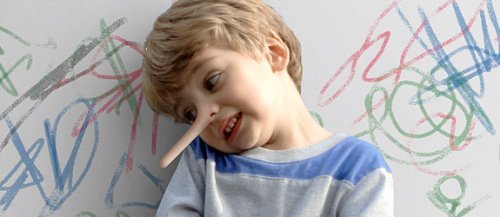Tools for Determining If Your Children Are Lying

Parents frequently ask themselves if their children are lying. There are moments when it’s hard to read whether or not our children are telling the truth.
As our little ones grow, it’s easier to detect their dishonesty. But in the meantime, how can you tell when your children are lying?
There are two things that happen when it comes to children lying. First, they acquire wisdom about what they “should” and “shouldn’t” tell parents to avoid alarming us. Second, most parents have a biased view of their children.
Fortunately, there are several tricks that can help us discover when our children are trying to hide something from us. It all depends on our observations, intuition and a bit of logic.
How can I tell if my children are lying: physical signs
Telling a lie involves physiological processes and mental skills. Adults get accustomed to their use and can better control their gesticulation to avoid discovery. However, this is more difficult for children.
In fact, children are prone to sweat, shake and confuse their words when they’re lying. In these situations, they give hurried responses because they’re trying to answer quickly and think at the same time.
You may also notice that their gestures are different than normal as well. To notice this, you’ll need to be sly and rely on your knowledge of your children’s usual gestures.
“Children are prone to sweat, shake and confuse their words when they’re lying.”
How can I tell if my children are lying? Look for flawed arguments
Lying is an argumentative process created in a complex emotional context. As a result, it often creates flaws. The repetition of phrases and words is one of the most common traps that children fall into when lying. But there are other patterns we can look out for as well.

For example, when children provide too many details about an occurrence, then it’s very possible they’re telling a lie. It’s normal for them to believe that providing more details is synonymous with trustworthiness. But it’s up to us to observe whether their story is logical or not.
And then, there’s always the typical “it wasn’t me” even when we haven’t accused them of anything. This attitude reveals a discomfort and awkwardness with which a child reacts to something that has happened. When children offer excuses when we haven’t asked for them, it’s a sure sign they’re hiding something.
How to tell if my children are lying: types of lies
Another important aspect in analyzing our children’s behavior is what type of lies they’re telling. As you already know, there are “white lies”, full-blown lies, and half truths. When children resort to half truths, they manipulate the truth for their own gain.
In general, “white lies” are mischievous and usually reveal something very minor. However, when it comes to half truths and full-blown lies, they may mean something more serious. We need to be very meticulous when going over the arguments our children provide.
In short, we can’t respond in the same way in the face of different types of lies and situations our children are trying to cover up. For example, having eaten an extra cookie is very different from sneaking off to the park without permission. Paying attention to the type of lie our child is telling can help us get to the bottom of what’s going on.
“There are white lies, full-blown lies, and half truths. When children resort to half truths, they manipulate the truth for their own gain.”
How should I react when my child is lying?
If you’ve asked yourself how to tell if your children are telling lies, then you also need to know how to respond when they do. Rather than turn into moral inquisitors, we need to analyze the human component of deceit. Truth be told, this is a resource that many adults use all the time.
What should concern us is repeated behaviors, manipulation and the naturalness with which our children lie. If we as parents resort to lying in different circumstances, how can we expect any different from our children. Therefore, it’s important to analyze each situation and each lie in an integral way.

At the same time, the moral education we give to our children should be based on real honesty. This implies something further: We shouldn’t resort to fear and manipulation when teaching our children. Rather, we should place priority on positive reinforcement.
We should act like parents who listen to the truth
On many occasions, children may resort to lying in order to cover up something really serious. Children don’t only lie about things they themselves have done. They may also lie about things that have been done to them, or things they’ve witnessed. It’s important that we as parents be ready to hear the truth.
Condemnation, exaggerated reprimands and intolerance only lead to further deceit. Tolerance, however, always leads to positive consequences. Therefore, always choose tolerance when dealing with your children.
All cited sources were thoroughly reviewed by our team to ensure their quality, reliability, currency, and validity. The bibliography of this article was considered reliable and of academic or scientific accuracy.
- Bach, K. & Harnish, R. M. (1979). Linguistic: Communication and speech acts. Cambridge, MA: MIT Press.
- Casas Rivera, R., & Zamarro Arranz, M. L. (1990). La mitomanía en la clínica actual. A propósito de un caso clínico. Revista de La Asociación Española de Neuropsiquiatría.
- Dithrich, C. W. (1993). Pseudologia fantastica, dissociation, and potential space in child treatment. Master Clinicians on Treating the Regressed Patient, Vol. 2.
- King, B. H., & Ford, C. V. (1988). Pseudologia fantastica. Acta Psychiatrica Scandinavica. https://doi.org/10.1111/j.1600-0447.1988.tb05068.x
- Leekam, S. R. (1992). Believing and deceiving: Steps to becoming a good lier. En S. J. Ceci, M. Desimone & M. Putnik (Eds.), Social and cognitive factors in early deception (pp. 47–62). Hillsdale, NJ: L.E.A.
- Sotillo, M., & Rivière, Á. (2001). Cuando los niños usan las palabras para engañar: la mentira como instrumento al servicio del desarrollo de las habilidades de inferencia mentalista. Infancia y aprendizaje, 24(3), 291-305. https://www.tandfonline.com/doi/abs/10.1174/021037001316949239
This text is provided for informational purposes only and does not replace consultation with a professional. If in doubt, consult your specialist.








